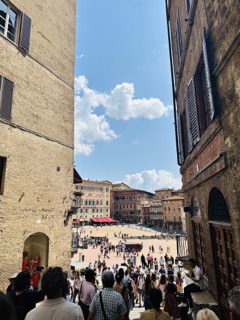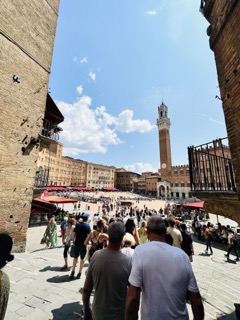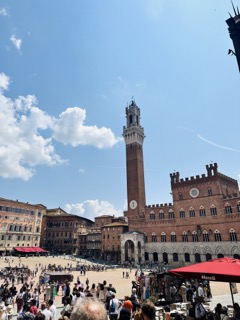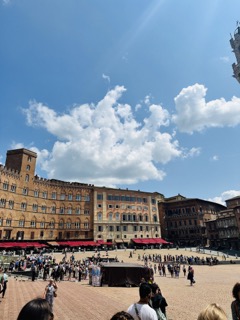Understanding the City of Siena and its famous Palio di Siena
- Gabrielle Keller

- Jun 2, 2023
- 6 min read
Updated: Jun 6, 2023

Siena
Siena, Italy, is a portal back to the Medieval times. Upon entry, the cobblestone streets and old, brick buildings make you feel like you are in the Middle Ages.

The city is located on three hills, with the center of the town at the lowest point. Legend has it that Siena was founded by Senio and Aschiano, the sons of Remo. The two fled into the woods from their angry uncle Romulus, where they escaped the She-Wolf and founded Siena. The symbol of Siena, the She-Wolf breastfeeding Romulus and Remus, is derived from this legend. The city is filled with these references. Roman She-Wolf mosaics and statues decorate many streets throughout the city.
Full of medieval tradition, Siena is known for its exciting horse racing events called the Palio di Siena. This event takes place twice every year and draws in thousands of tourists that are aching to see it in person.
Understanding the Contrada
The history of Siena’s Palio is dependent on the seventeen contrade (plural of contrada), or districts, of Siena. To understand the Palio’s history one needs to be familiarized with these neighborhoods.

The origin of these neighborhoods is difficult to precisely date, but there is evidence that they began during the Middle Ages to supply troops to the several military organizations that defended Siena against Florence. Now, these districts cease to have any military function but instead act as small, patriotic city-states. Other sources claim that the contrade developed as a result of the celebration of solemn events during the fifteenth century. The city would represent different mourners by using wooden devices shaped like animals. The groups of mourners were organized by these devices which later developed into their district names.
Much like the districts in the hunger games or the houses of Hogwarts, the city of Siena is divided into different contrade within city lines. Originally, Siena had around sixty contrade, but now only seventeen remain. The seventeen different contrada each have unique names: porcupine, she-wolf, caterpillar, dragon, giraffe, goose, owl, unicorn, tower, forest, eagle, shell, panther, snail, tortoise, wave and ram.

These Contrade function like city-states, each having its own local government, elected officials, government authority, and even constitutions. Perhaps the most iconic and apparent emblem of separation between Siena’s different neighborhoods is the flags. Each Contrada is represented by its own flag and is adorned all over the streets and buildings with them. There is a vast differentiation of neighborhoods because of the distinct flags. When walking, a person can immediately tell which community they are in based on how it is decorated. Additionally, each contrada flag has a motto on it representing their neighborhood values.

The motto and emblem are also decorated on other traditional art and architecture. In fact, each historical building is decorated with small, colorful coats of arms. The design of the coats or arms indicates the contrada and territory.
In addition to traditional flags and art, Sienese citizens also wear their emblems proudly. At birth, a person from Siena is given a silk scarf that represents the neighborhood they are from. The citizens of Siena have great pride and loyalty to the Contrade they were born into.
“A person can move in between Contrades, but their loyalty always remains with the one they are from originally. You will always root for the one you are born from during the Palio,” says Ilaria, a tour guide of Siena. She is a member of the Niccio, or Shell district but she was born in a town forty minutes away from the city.

This great sense of pride makes the Palio horse races such a big deal in Siena. The members of the districts become so excited and invested in their own Contrada. In addition to the sense of loyalty creating a competitive atmosphere for the Palio di Siena, the relationships between the Contrade also help to foster healthy rivalry. There are four types of relationships between the contrade: alliances, friendships, rivalry, or no relationship. Relationships between city-states can change over time if a contrada aids another in Palio’s victory or even governmental settlements.
“For years, the Giraffe and Caterpillar neighborhoods were enemies,” says Ilaria, “but a peace treaty was made in 1996, so now the rivalry has ended.”
The competitive nature of the contrada aids and destroys camaraderie during the Palio di Siena, creating a more intense and fun environment for the horse races.
History of the Palio di Siena Horse Races
The Palio di Siena is a horse race that takes place twice a year in Siena. It is an 800-year-old tradition, making it the oldest horserace in the world. Its origins date back to medieval times. Siena’s Piazza del Campo, or central piazza, was the site of many town-wide competitions such as boxing, jousting, and bullfighting. The city also held horse races called palii alla lunga that spanned the distance of the entire city. These races started just outside of the city walls and ended at the Duomo in Siena.

In 1324, punching was abolished in Siena. This was because the punching led to players throwing stones at each other, then weapons and sticks. This caused violent battles during these games to ensue. In order to re-establish a sense of order within the community, the Bishop ordered a train of priests and monks to walk to the Piazza di Campo. This train developed into the parade that now currently takes place during the days leading up to the race.
In 1590, the Grand Duke of Tuscany outlawed bullfighting. Instead of holding violent fights and games in the Piazza del Campo, the contrade decided to host racing in the town center. The first of these races was bufalate, which was a bareback race on buffalo. Soon, a donkey-back race replaced the buffalo race. It then developed into a horse race. The first modern Palio at the Piazza del Campo was held in 1633.
The City During the Palio di Siena
` Though the Palio di Siena draws in a lot of tourism to the city, it is not an event organized for tourism purposes. It is a cultural celebration for the Sienese people themselves. Tourists can’t have the same sense of excitement, understanding, or pride for a specific contrada because they will never be a part of one. As mentioned, one can only be a member of a Contrada if one were born into it, or through family ties. So, only those with a relation to a contrada can feel a sense of pride for one. Tourists can come to Siena and see the Palio, but choosing a team to root for is usually just for fun and to experience a different culture.

“The busiest time of year is during the races. Tourists come to watch the excitement. It is fun to see even if you aren’t from Siena. Tourists watch to see Sienese tradition and the contrade spirit,” says Martina, a worker at a local bar in Siena.
The Palio takes place twice a year. The first date is July 2nd, which is meant to honor the Madonna of Provenzano. The second race takes place on August 16th and is a tribute to the Assumption of Mary. The event lasts four days. The drawing of the horses takes place on the first day. This is when each competing contrada gets assigned a horse. Horses are drawn in a lottery system, and purebreds are not allowed.
There are only ten contrade prohibited to compete at a time. Since there are seventeen contrada, seven of them do not participate in the race. The contrade that are chosen to play is based on who didn't compete in the last race. The seven districts are automatically chosen to compete, while the other three spots are filled through a lottery system.
50,000 people show up to watch the race. Officials must set up days in advance to accommodate this crowd. Dirt is used to cover the piazza for the race, bleachers are set up, and other town activities are organized during the time leading up to the race.
“The race only lasts around a minute, but we celebrate it all day. Sienese people live for the Palio, it is in our blood, ” says Martina.
At 8 am, the event begins. The day starts with a blessing from the bishop of the town. Next, the mayor certifies each horse and jockey, followed by a ceremony of the contrade blessings for each horse. Next, there is a large and whimsical pageant that has activities reflecting the medieval times such as sword-wielding carabinieri on horseback. Before the racing, thousands of people have dinner outdoors in the different contrades. Finally, the race takes place at the Piazza del Campo. The horses race around the circumference of the town square. Even though the race is only around 90 seconds, parties and celebrations continue long after it is finished.
Different angles of the Piazza del Campo before it is prepared for the Palio di Siena
Siena, Italy is such an interesting city that values its vibrant and alive Medieval culture. The Palio di Siena defines the city and makes it a destination for so many people. The event showcases the hospitality and pride of Siena, making it one of the most interesting and welcoming places to visit.






















Comments